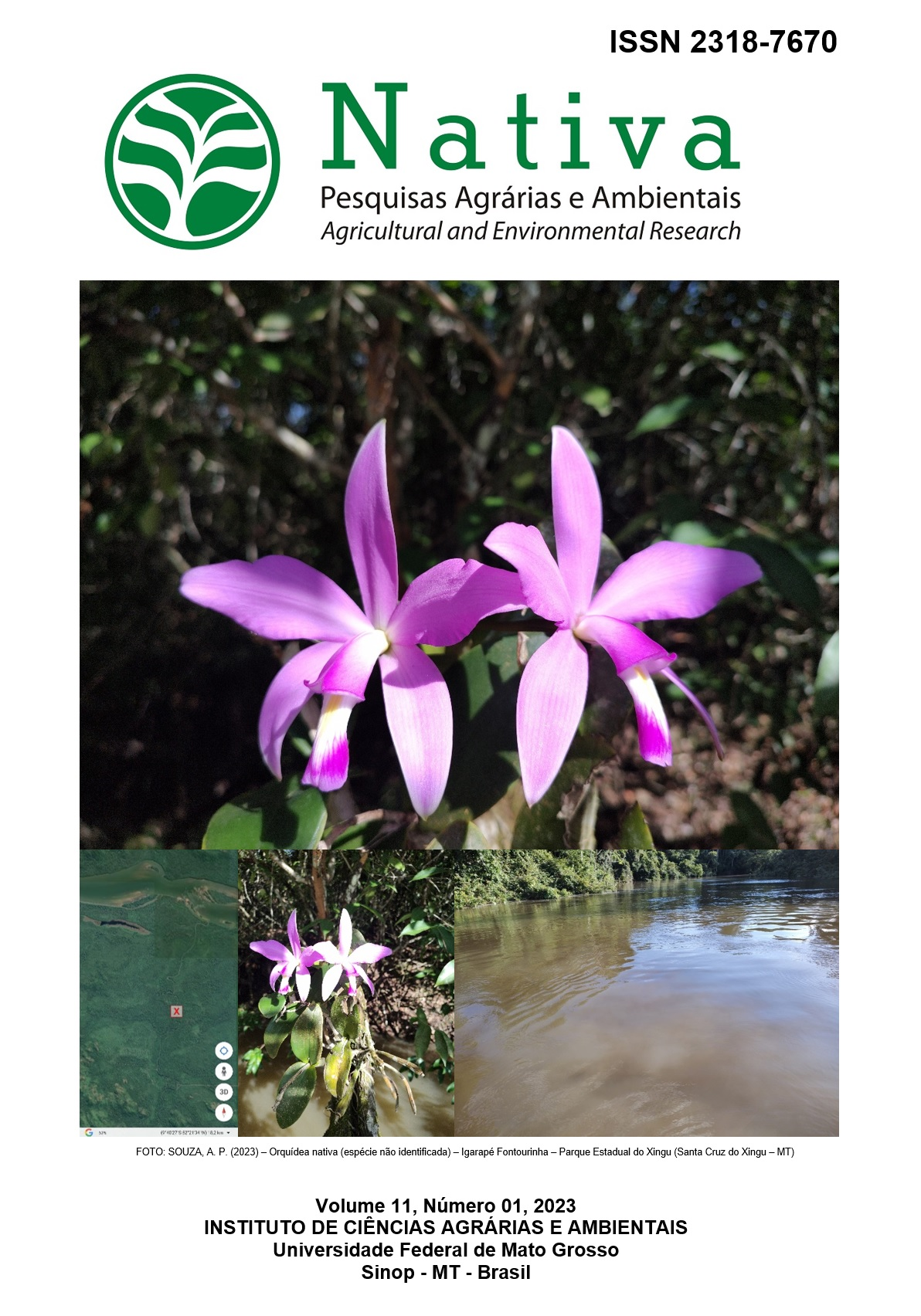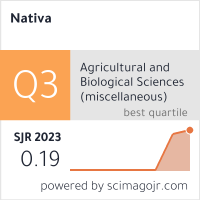USO DE ROCHA CARBONÁTICA E MICRORGANISMOS COMO SUPRIMENTO ALTERNATIVO DE FÓSFORO
DOI:
https://doi.org/10.31413/nativa.v11i1.13863Palavras-chave:
remineralizador, bioestimulantes, solubilizador, Zea maysResumo
As reações de fixação de fósforo (P) em solos tropicais está entre as principais limitações para a agricultura, exigindo quantidades para adubações acima do requerido pelas culturas. Como as fontes de P são esgotáveis e esse é um elemento essencial, a busca de estratégias sustentáveis para seu suprimento torna-se imprescindível. Desse modo, avaliamos a aplicação de pó de rocha de carbonatito (PR) combinado com superfosfato simples (SS) associados à inoculação com microrganismos, no desenvolvimento inicial da cultura do milho. O experimento foi desenvolvido em casa de vegetação, sob esquema fatorial 6 x 4, sendo: Seis formas de adubação fosfatada (0% de P; 100% de SS e PR; três combinações proporcionais de SS+PR), e quatro inoculações (Ceratobasidium sp.; Tulasnella sp.; Mix de Bacillus megaterium + Bacillus subtilis; sem inoculante). As combinações 75% de SS + 25% de PR e 50% SS + 50 % PR proporcionaram incrementos de até 87% de biomassa aérea seca comparando-as ao controle, e 49% com a utilização de somente SS. A utilização de PR pode ser uma alternativa para redução de fontes solúveis de P na adubação inicial da cultura do milho. Todos os inoculantes quando aplicados sem adubação fosfatada, foram eficientes para manter o desenvolvimento inicial do milho em um solo de plantio direto.
Palavras-chave: remineralizador; bioestimulantes; solubilizador; Zea mays.
Use of carbonate rock and microorganisms as alternative phosphorus supply
ABSTRACT: Phosphorus (P) fixation reactions in tropical soils are among the main limitations for agriculture, requiring amounts of fertilizers above those required by crops. As P sources are exhaustible and this is an essential element, the search for sustainable strategies for its supply becomes essential. Thus, we evaluated the application of carbonatite rock powder (PR) combined with single superphosphate (SS) associated with inoculation with microorganisms, in the initial development of the corn crop. The experiment was carried out in a greenhouse, under a 6 x 4 factorial scheme, as follows: Six forms of phosphate fertilization (0% P; 100% SS and PR; three proportional combinations of SS+PR), and four inoculations (Ceratobasidium sp.; Tulasnella sp.; Mix of Bacillus megaterium + Bacillus subtilis; no inoculant). The combinations of 75% SS + 25% PR and 50% SS + 50% PR provided increments of up to 87% of dry aerial biomass compared to the control, and 49% with the use of SS alone. The use of PR can be an alternative to reduce soluble sources of P in the initial fertilization of the corn crop. All inoculants, when applied without phosphate fertilization, were efficient to maintain the initial development of corn in a no-tillage soil.
Keywords: remineralizer; biostimulants; solubilizer; Zea mays.
Referências
AHEMAD, M.; KIBRET, M. Mechanisms and applications of plant growth promoting rhizobacteria: Current perspective. Journal of King Saud University Science, 26, p. 1-20, 2014. https://doi.org/10.1016/j.jksus.2013.05.001
AMANULLAH; KHAN, A. Phosphorus and compost management influence maize (Zea mays) productivity under semiarid condition with and without phosphate solubilizing bacteria. Frontiers in Plant Science, v. 6, e1083, 2015. https://doi.org/10.3389/fpls.2015.01083
ARAÚJO, F. H. V.; CRUZ, R. S.; PORTO, D. W. B.; MACHADO, C. M. M.; FRANÇA, A. C. Effects of mycorrhizal association and phosphate fertilization on the initial growth of coffee plants. Pesquisa Agropecuaria Tropical, v. 50, e58646, 2020. https://doi.org/10.1590/1983-40632020v5058646
BRUNDRETT, M.; BOUGHER, N.; DELL, B.; GROVE, T.; MALAJCZUK, N. Working with mycorrhizas in forest and agriculture. Gamberra, v. 135, n. 4, p. 783-784, 1997. https://doi.org/10.1046/j.1469-8137.1997.00703-7.x
CARDOSO, E. J. B. N.; NOGUEIRA, M. A.; ZANGARO, W. Importance of mycorrhizae in tropical soils. In: Azevedo, J., Quecine, M. (Eds.) Diversity and benefits of microorganisms from the tropics. Switzerland: Springer - Cham, 2017. p. 245-267. https://doi.org/10.1007/978-3-319-55804-2_11.
DE SOUSA, S. M.; OLIVEIRA, C. A.; ANDRADE, D. L.; CARVALHO, C. G.; RIBEIRO, V. P.; PASTINA, M. M.; MARRIEL, I. E.; LANA, U. G. de P.; GOMES, E. A. Tropical Bacillus Strains Inoculation Enhances Maize Root Surface Area, Dry Weight, Nutrient Uptake and Grain Yield. Journal of Plant Growth Regulation, v. 40, n. 2, p. 867-877, 2020. https://doi.org/10.1007/s00344-020-10146-9
EO, J.; PARK, K. C.; KIM, M. H. Plant-specific effects of sunn hemp (Crotalaria juncea) and sudex (Sorghum bicolor×Sorghum bicolor var. sudanense) on the abundance and composition of soil microbial community. Agriculture, Ecosystems and Environment, v. 213, p. 86-93, 2015. https://doi.org/10.1016/j.agee.2015.07.025
FERREIRA, E. B.; CAVALCANTI, P. P.; NOGUEIRA, D. A. ExpDes: An R Package for ANOVA and Experimental Designs. Applied Mathematics, v. 5, n. 19, p. 2952-2958, 2014. https://doi.org/10.4236/am.2014.519280
JANSA, J.; FORCZEK, S. T.; ROZMOS, M.; PUSCHEL, D.; BUKOVSKÁ, P.; HRSELOVÁ, H. Arbuscular mycorrhiza and soil organic nitrogen: network of players and interactions. Chemical and Biological Technologies in Agriculture, v. 6, e10, 2019. https://doi.org/10.1186/s40538-019-0147-2
JENKINS, R. X-Ray Fluorescence Spectrometry. 2 ed. John Wiley and Sons, 1999. 232p.
KAISER, C.; KILBURN, M. R.; CLODE, P. L.; FUCHSLUEGER, L.; KORANDA, M.; CLIFF, J. B.; SOLAIMAN, Z. M.; MURPHY, D. V. Exploring the transfer of recent plant photosynthates to soil microbes: Mycorrhizal pathway vs direct root exudation. New Phytologist, v. 205, n. 4, P. 1531-1551, 2015. https://doi.org/10.1111/nph.13138
LANNA-FILHO, R.; FERRO, H. M.; PINHO, R. S. C. de. Controle biológico mediado por Bacillus subtilis. Revista Trópica: Ciências Agrárias e Biológicas, v. 4, n. 2, p. 12-20, 2010. https://doi.org/10.0000/rtcab.v4i2.145
MORAIS, T. P. de; BRITO, C. H. de; FERREIRA, A. de s.; LUZ, J. M. Q. Aspectos morfofisiológicos de plantas de milho e bioquímico do solo em resposta à adubação nitrogenada e à inoculação com Azospirillum brasilense. Revista Ceres, v. 62, n. 6, p. 589-596, 2015. https://doi.org/10.1590/0034-737X201562060012
NAVROSKI, D.; MOREIRA, A.; GUIMARÃES, M. de F.; COLOZZI FILHO, A. Changes in microbiological attributes of a red latosol under different cropping systems. Semina: Ciencias Agrarias, v. 39, n. 3, p. 971-982, 2018. https://doi.org/10.5433/1679-0359.2018v39n3p971
OLIVEIRA JÚNIOR, A. de; PROCHNOW, L. I.; KLEPKER, D. Soybean yield in response to application of phosphate rock associated with triple superphosphate. Scientia Agricola, v. 68, n. 3, p. 376-385, 2011. https://doi.org/10.1590/S0103-90162011000300016
PAVINATO, P. S.; CHERUBIN, M. R.; SOLTANGHEISI, A.; ROCAH, G. C.; CHADWICK, D. R.; JONES, D. L. Revealing soil legacy phosphorus to promote sustainable agriculture in Brazil. Scientific Reports, v. 10, n. 1, e15615, 2020. https://doi.org/10.1038/s41598-020-72302-1
R CORE TEAM. R: A language and environment for statistical computing. R Foundation for Statistical Computing, 2021.
RAIJ, B. Van; ANDRADE, J. C. de; CANTARELLA, H.; QUAGGIO, J. A. Análise química para avaliação da fertilidade de solos tropicais. Campinas: Instituto Agronômico, 2001. 285p.
RICHARDSON, A. E. Prospects for using soil microorganisms to improve the acquisition of phosphorus by plants. Australian Journal of Plant Physiology, v. 28, n. 9, p. 897-906, 2001. https://doi.org/10.1071/PP01093
SATYAPRAKASH, M.; B. SADHANA, T. NIKITHA, E. U. B. R.; VANI, S. S. Phosphorous and Phosphate Solubilising Bacteria and their Role in Plant Nutrition. International Journal of Current Microbiology and Applied Sciences, v. 6, n. 4, p. 2133-2144, 2017. https://doi.org/10.20546/ijcmas.2017.604.251
SOMA, D. M.; KIBA, D. I.; GNANKAMBARY, Z.; EWUSI-MENSAH, N.; SANOU, M.; NACRO, H. B.; LOMPO, F.; SEDOGO, M. P.; ABAIDOO, R. C. Effectiveness of combined application of Kodjari phosphate rock, water soluble phosphorus fertilizer and manure in a Ferric Lixisol in the centre west of Burkina Faso. Archives of Agronomy and Soil Science, v. 64, n. 3, p. 384-397, 2018. https://doi.org/10.1080/03650340.2017.1353216
SOUZA, D. M. G. DE; LOBATO, E. Cerrado: correção do solo e adubação. 2 ed. Brasília: Embrapa Informação Tecnológica, 2004. p. 147-167.
TABATABAI, M. A. Soil enzymes. In: BOTTOMLEY, P. J.; ANGLE, J. S.; WEAVER, R. W. (Eds). Methods of soil analysis: microbiological and biochemical properties. Soil Science Society of America, v. 2, p. 778-835, 1994. https://doi.org/10.2136/sssabookser5.2.c37
TEIXEIRA, P. C.; DONAGEMMA, G. K.; FONTANA, A.; TEIXEIRA, W. G. (Eds). Manual de métodos de análise de solo. 3. ed. rev. e ampl. – Brasília, DF: Embrapa, 2017. 547p.
VERMELHO, A. B.; PEREIRA, A.; COELHO, R.; SOUTO-PADRÓN, T. Práticas de Microbiologia. Rio de Janeiro: Guanabara Koogan, 2006. 208p.
VINHA, A. P. C.; CARRARA, B. H.; SOUZA, E. F. S.; SANTOS, J. A. F. dos; ARANTES, S. A. C. M. Adsorção de fósforo em solos de regiões tropicais. Nativa, v. 9, n. 1, p. 30-35, 2021. https://doi.org/10.31413/nativa.v9i1.10973
ZHAO, K.; PENTTINEN, P.; ZHANG, X.; AO, X.; LIU, M.; YU, X.; CHEN, Q. Maize rhizosphere in Sichuan, China, hosts plant growth promoting Burkholderia cepacia with phosphate solubilizing and antifungal abilities. Microbiological Research, v. 169, n. 1, p. 76-82, 2014. https://doi.org/10.1016/j.micres.2013.07.003
Downloads
Publicado
Edição
Seção
Como Citar
Licença
Copyright (c) 2023 Nativa

Este trabalho está licenciado sob uma licença Creative Commons Attribution-NonCommercial 4.0 International License.
Direitos Autorais para artigos publicados nesta revista são do autor, com direitos de primeira publicação para a revista. Em virtude de a aparecerem nesta revista de acesso público, os artigos são de uso gratuito, com atribuições próprias, em aplicações educacionais e não-comerciais.
A artigos publicados nessa revista, podem ser reproduzidos parcialmente ou utilizados como referência por outros autores, desde que seja cita a fonte, ou seja, a Revista Nativa.
Copyright for articles published in this journal are the authors, with first publication rights granted to the journal. The journal shows open access, and articles are free to use, with proper attribution, in educational and non-commercial.
The articles published in this journal may be reproduced in part or used as a reference by other authors, provided that the source is quoted.






